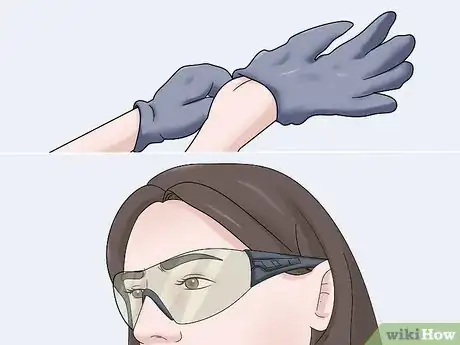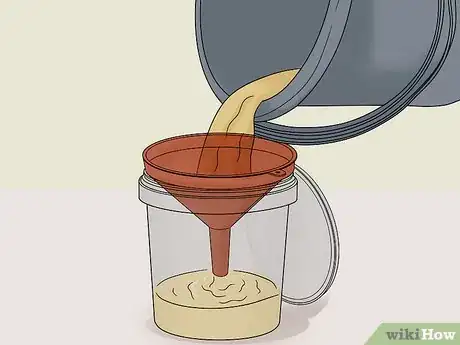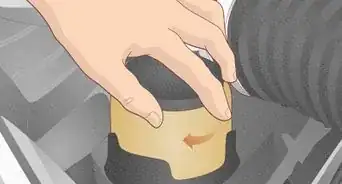This article was co-authored by wikiHow Staff. Our trained team of editors and researchers validate articles for accuracy and comprehensiveness. wikiHow's Content Management Team carefully monitors the work from our editorial staff to ensure that each article is backed by trusted research and meets our high quality standards.
This article has been viewed 14,438 times.
Learn more...
Power steering fluid has to be changed every so often, leaving you with the old fluid left over that needs to be disposed of. Old power steering fluid is a toxic substance that can pollute water and air, so putting it in the regular garbage is unsafe and often illegal. Fortunately, power steering fluid is recyclable, and waste facilities can clean and reuse it in other vehicles. All you have to do is collect and seal the fluid safely, then drop it off at a waste disposal facility and let them take care of the rest.
Steps
Handling and Storing Power Steering Fluid
-
1Put on gloves and goggles to protect yourself. Power steering fluid is a toxic material that could irritate your skin and eyes. Always put on gloves and goggles before handling it.[1]
- If you get any fluid on your skin, wash it off normally with soap and water. If any gets in your eyes, flush them out with clean water for 15 minutes and then contact Poison Control.
- Seek immediate medical attention if someone ingests the fluid.
-
2Transfer the fluid into a sealable container. Start by flushing the steering fluid into a clean pan or bucket. Put a funnel into a jug or bottle so you don’t spill the fluid. Then take the pan and carefully pour the fluid out and into the funnel. When you’re done, close the container tightly.[2]
- Make sure the pan and container are completely clean. If the fluid mixes with dust or any other chemicals, it can’t be recycled.
- The container can be plastic or metal. The important thing is that it’s sealable.
- Depending on the waste facility you go to, you may not get the container back, so don’t use a container you want to keep. A popular trick is pouring the old fluid into the empty bottle that the new fluid came in. That way, you don’t have to use your own container.
Advertisement -
3Label the container as “Used Power Steering Fluid.” This helps waste disposal professionals identify the container’s contents and dispose of it correctly. Place a strip of masking tape on the container and write “Used Power Steering” in large letters with permanent marker.[3]
- This is good practice for all automotive waste fluids. Whether you’re disposing of antifreeze, oil, or steering fluid, always label the container.
-
4Store the container away from children and pets. Steering fluid is toxic, so store it safely if you don’t bring it to a waste disposal site right away. If you have children or pets, put the container on a high shelf in your garage or shed that they can’t reach. Keep the container out of direct sunlight as well.[4]
Finding a Disposal Site for Power Steering Fluid
-
1Take the fluid to a local repair or parts shop for a convenient option. This is the most popular choice for car owners to dispose of their automotive waste. In the US, large auto repair and parts stores often run their own recycling centers, and you can drop off waste materials at any time the store is open. Find auto shops near you and call them to see if they collect waste products. If so, bring the container of steering fluid in during store hours.[5]
- Big chain stores like Pep Boys, Jiffy Lube, and AutoZone are more likely to operate recycling facilities. Some other local repair shops may also accept the fluid.
- Some gas stations may also accept the fluid if the site has a repair shop.
-
2Drop the fluid at your county's waste disposal site if there is one. Most cities and counties in the US have hazardous waste disposal sites that collect steering fluid. Look online to see if your local government operates a waste facility and check the times that they accept drop-offs. Bring the container of steering fluid in during the posted hours.[6]
- State-run facilities sometimes only open on certain days during the month, so make sure to confirm the collection times with the facility. This makes dropping waste off at state facilities a bit less convenient than bringing it to a repair shop.
- Follow all the instructions for disposing of the fluid at the collection site. Some sites have employees that will just take the container, while others may ask you to pour the fluid into a storage tank and throw the container into a designated bin.[7]
- If you’re outside the US, check if your local government runs disposal sites like these.
-
3Contact a waste-disposal business if you want the fluid picked up. For a more convenient option, you could have a company come and pick up the fluid. Check if there are waste disposal businesses in your area, and contact them for a price to collect your steering fluid. They’ll schedule a pickup time and ask you to leave the container at the curbside. This way, you don’t have to transport the fluid yourself.[8]
- Companies charge a fee for home pickup. Different companies have different charges, depending on how much fluid you want removed. The service may cost between $10 and $50, depending on your area and the amount. Bring the fluid elsewhere if you don’t want to pay. However, if you don't want to be bothered with transporting the fluid yourself, then the fee may be worth it to you.
Warnings
- Never dispose of steering fluid, or any other automotive waste, in the regular garbage or pour it down a drain. This pollutes the water supply and you could face a high fine or even jail time if you’re caught.⧼thumbs_response⧽
References
- ↑ https://www.idealrm.com/application/files/4014/8285/3453/NAPA_Power_Steering_Fluid.pdf
- ↑ https://fonddulac.extension.wisc.edu/files/2012/01/Waste-oil-and-other-automotive-products.pdf
- ↑ https://www.popularmechanics.com/cars/how-to/a329/2063646/
- ↑ https://www.popularmechanics.com/cars/how-to/a329/2063646/
- ↑ https://www.epa.gov/uic/motor-vehicle-waste-disposal-wells
- ↑ https://www.epa.gov/uic/motor-vehicle-waste-disposal-wells
- ↑ https://www.fairfaxcounty.gov/publicworks/recycling-trash/household-hazardous-waste
- ↑ https://archive.epa.gov/wastes/conserve/materials/usedoil/web/html/usedoil.html
